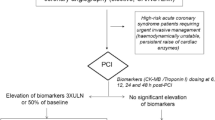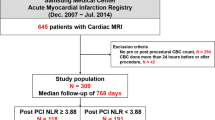Abstract
The prognostic role of neutrophil-to-lymphocyte ratio (NLR) and platelet-to-lymphocyte ratio (PLR) in patients with stable coronary artery disease (CAD) is still unclear. We enrolled 500 patients undergoing elective percutaneous coronary intervention (PCI). Blood samples were drawn prior to PCI for NLR and PLR calculation. Major adverse clinical events (MACE), which included death, myocardial infarction (MI), and target vessel revascularization (TVR), were recorded up to 5 years. Patients in the higher tertile of NLR presented higher Kaplan–Meier estimates of MACE (26.0% vs. 16.9% in tertile 2 vs. 14.3% in tertile 1; p = 0.042) and death (12.0% vs 6.9% in tertile 2 vs. 4.6% in tertile 1; p = 0.040), whereas there were no significant differences in the estimates of MI and TVR. NLR in the higher tertile was an independent predictor of MACE (HR 1.65, 95% CI 1.07–2.55, p = 0.024). No significant difference was observed across tertiles of PLR. Unlike PLR, elevated pre-procedural NLR is associated with an increased risk of 5-year clinical adverse events.


Similar content being viewed by others
References
Ross, R. (1999). Atherosclerosis—an inflammatory disease. The New England Journal of Medicine, 340(2), 115–126.
Ridker, P. M., Everett, B. M., Thuren, T., MacFadyen, J. G., Chang, W. H., Ballantyne, C., Fonseca, F., Nicolau, J., Koenig, W., Anker, S. D., Kastelein, J. J. P., Cornel, J. H., Pais, P., Pella, D., Genest, J., Cifkova, R., Lorenzatti, A., Forster, T., Kobalava, Z., Vida-Simiti, L., Flather, M., Shimokawa, H., Ogawa, H., Dellborg, M., Rossi, P. R. F., Troquay, R. P. T., Libby, P., Glynn, R. J., & CANTOS Trial Group. (2017). Antiinflammatory therapy with canakinumab for atherosclerotic disease. The New England Journal of Medicine, 377(12), 1119–1131.
Davì, G., & Patrono, C. (2007). Platelet activation and atherothrombosis. The New England Journal of Medicine, 357(24), 2482–2494.
Mangiacapra, F., & Barbato, E. (2013). Clinical implications of platelet-vessel interaction. Journal of Cardiovascular Translational Research, 6(3), 310–315.
Sabatine, M. S., Morrow, D. A., Cannon, C. P., Murphy, S. A., Demopoulos, L. A., et al. (2002). Relationship between baseline white blood cell count and degree of coronary artery disease and mortality in patients with acute coronary syndromes: a TACTICS-TIMI 18 (Treat Angina with Aggrastat and determine Cost of Therapy with an Invasive or Conservative Strategy—Thrombolysis in Myocardial Infarction 18 trial) substudy. Journal of the American College of Cardiology, 40, 1761–1768.
Onsrud, M., & Thorsby, E. (1981). Influence of in vivo hydrocortisone on some human blood lymphocyte subpopulations. I. Effect on natural killer cell activity. Scandinavian Journal of Immunology, 13, 573–579.
Bressi, E., Mangiacapra, F., Ricottini, E., Cavallari, I., Colaiori, I., Di Gioia, G., Creta, A., & Di Sciascio, G. (2016). Relation of neutrophil to lymphocyte ratio with periprocedural myocardial damage in patients undergoing elective percutaneous coronary intervention. The American Journal of Cardiology, 118(7), 980–984.
Cho, K. I., Ann, S. H., Singh, G. B., Her, A. Y., & Shin, E. S. (2015). Combined usefulness of the platelet-to-lymphocyte ratio and the neutrophil-to-lymphocyte ratio in predicting the long-term adverse events in patients who have undergone percutaneous coronary intervention with a drug-eluting stent. PLoS One, 10(7), e0133934.
Park, J. J., Jang, H. J., Oh, I. Y., Yoon, C. H., Suh, J. W., et al. (2013). Prognostic value of neutrophil to lymphocyte ratio in patients presenting with ST-elevation myocardial infarction undergoing primary percutaneous coronary intervention. The American Journal of Cardiology, 111, 636–642.
White, H., Thygesen, K., Alpert, J. S., & Jaffe, A. (2014). Universal MI definition update for cardiovascular disease. Current Cardiology Reports, 16(6), 492.
Cutlip, D. E., Windecker, S., Mehran, R., Boam, A., Cohen, D. J., van Es, G. A., et al. (2007). Clinical end points in coronary stent trials: a case for standardized definitions. Circulation, 115, 2344–2351.
Hicks, K. A., Tcheng, J. E., Bozkurt, B., Chaitman, B. R., Cutlip, D. E., Farb, A., Fonarow, G. C., Jacobs, J. P., Jaff, M. R., Lichtman, J. H., Limacher, M. C., Mahaffey, K. W., Mehran, R., Nissen, S. E., Smith, E. E., & Targum, S. L. (2015). 2014 ACC/AHA key data elements and definitions for cardiovascular endpoint events in clinical trials: a report of the American College of Cardiology/American Heart Association Task Force on Clinical Data Standards (Writing Committee to Develop Cardiovascular Endpoints Data Standards). Journal of the American College of Cardiology, 66(4), 403–469.
Van Tassell, B. W., Toldo, S., Mezzaroma, E., & Abbate, A. (2013). Targeting interleukin-1 in heart disease. Circulation, 128(17), 1910–1923.
Hotchkiss, R. S., & Karl, I. E. (2003). The pathophysiology and treatment of sepsis. The New England Journal of Medicine, 348, 138–150.
Kaya, M. G., Akpek, M., Lam, Y. Y., Yarlioglues, M., Celik, T., et al. (2013). Prognostic value of neutrophil/lymphocyte ratio in patients with ST-elevated myocardial infarction undergoing primary coronary intervention: a prospective, multicenter study. International Journal of Cardiology, 168, 1154–1159.
Wang, X., Zhang, G., Jiang, X., Zhu, H., Lu, Z., & Xu, L. (2014). Neutrophil to lymphocyte ratio in relation to risk of all-cause mortality and cardiovascular events among patients undergoing angiography or cardiac revascularization: a meta-analysis of observational studies. Atherosclerosis, 234, 206–213.
Wada, H., Dohi, T., Miyauchi, K., Shitara, J., Endo, H., Doi, S., Konishi, H., Naito, R., Tsuboi, S., Ogita, M., Kasai, T., Hassan, A., Okazaki, S., Isoda, K., Suwa, S., & Daida, H. (2017). Pre-procedural neutrophil-to-lymphocyte ratio and long-term cardiac outcomes after percutaneous coronary intervention for stable coronary artery disease. Atherosclerosis, 265, 35–40.
Muller, O., Hamilos, M., Bartunek, J., Ulrichts, H., Mangiacapra, F., Holz, J. B., Ntalianis, A., Trana, C., Dierickx, K., Vercruysse, K., De Bruyne, B., Wijns, W., & Barbato, E. (2010). Relation of endothelial function to residual platelet reactivity after clopidogrel in patients with stable angina pectoris undergoing percutaneous coronary intervention. The American Journal of Cardiology, 105(3), 333–338.
Mangiacapra, F., Bartunek, J., Bijnens, N., Peace, A. J., Dierickx, K., Bailleul, E., Di Serafino, L., Pyxaras, S. A., Fraeyman, A., Meeus, P., Rutten, M., De Bruyne, B., Wijns, W., van de Vosse, F., & Barbato, E. (2012). Periprocedural variations of platelet reactivity during elective percutaneous coronary intervention. Journal of Thrombosis and Haemostasis, 10(12), 2452–2461.
Mangiacapra, F., Colaiori, I., Ricottini, E., Creta, A., Di Gioia, G., Cavallari, I., Bressi, E., Capuano, M., Barbato, E., & Di Sciascio, G. (2018). Impact of platelet reactivity on 5-year clinical outcomes following percutaneous coronary intervention: a landmark analysis. Journal of Thrombosis and Thrombolysis, 45(4), 496–503.
Leader, A., Pereg, D., & Lishner, M. (2012). Are platelet volume indices of clinical use? A multidisciplinary review. Annals of Medicine, 44(8), 805–816.
Ricottini, E., Mangiacapra, F., Nusca, A., Melfi, R., Cavallari, I., Miglionico, M., Gallo, P., Pozzilli, P., & Di Sciascio, G. (2018). Relation of platelet indexes to platelet reactivity and periprocedural myocardial infarction in patients who underwent percutaneous coronary angioplasty. The American Journal of Cardiology, 121(9), 1027–1031.
Lee, Y. S. G., Baradi, A., Peverelle, M., Sultani, R., Adams, H., Garlick, J., & Wilson, A. M. (2018). Usefulness of platelet-to-lymphocyte ratio to predict long-term all-cause mortality in patients at high risk of coronary artery disease who underwent coronary angiography. The American Journal of Cardiology, 121(9), 1021–1026.
Li, H., Zhou, Y., Ma, Y., Han, S., & Zhou, L. (2017). The prognostic value of the platelet-to lymphocyte ratio in acute coronary syndrome: a systematic review and meta-analysis. Kardiologia Polska, 75(7), 666–673.
Olędzki, S., Kornacewicz-Jach, Z., Safranow, K., Kiedrowicz, R., Gawrońska-Szklarz, B., Jastrzębska, M., & Gorący, J. (2017). Variability of platelet response to clopidogrel is not related to adverse cardiovascular events in patients with stable coronary artery disease undergoing percutaneous coronary intervention. European Journal of Clinical Pharmacology, 73(9), 1085–1094.
Erhart, S., Beer, J. H., & Reinhart, W. H. (1999). Influence of aspirin on platelet count and volume in humans. Acta Haematologica, 101(3), 140–144.
Tonyali, S., Ceylan, C., Yahsi, S., & Karakan, M. S. (2018). Does neutrophil to lymphocyte ratio demonstrate deterioration in renal function? Renal Failure, 40(1), 209–212.
Neuen, B. L., Leather, N., Greenwood, A. M., Gunnarsson, R., Cho, Y., & Mantha, M. L. (2016). Neutrophil-lymphocyte ratio predicts cardiovascular and all-cause mortality in hemodialysis patients. Renal Failure, 38(1), 70–76.
Seropian, I. M., Romeo, F. J., Pizarro, R., Vulcano, N. O., Posatini, R. A., Marenchino, R. G., Berrocal, D. H., & Belziti, C. A. (2018). Neutrophil-to-lymphocyte ratio and platelet-to-lymphocyte ratio as predictors of survival after heart transplantation. ESC Heart Fail., 5(1), 149–156.
Author information
Authors and Affiliations
Corresponding author
Ethics declarations
Conflict of Interest
The authors declare that they have no conflict of interest.
Ethical Approval
All procedures performed in studies involving human participants were in accordance with the ethical standards of the institutional and/or national research committee and with the 1964 Helsinki declaration and its later amendments or comparable ethical standards.
Informed Consent
Informed consent was obtained from all individual participants included in the study.
Additional information
Associate Editor Craig Stolen oversaw the review of this article
Key Messages
The results of our study suggest that neutrophil-to-lymphocyte ratio (NLR), a simple and easily available inflammatory marker, may be used for risk stratification of patients undergoing elective percutaneous coronary revascularization, in that elevated pre-procedural values of NLR may help identify those patients at higher risk of future clinical adverse events. These patients may potentially benefit from tailored therapeutic strategies, such as more aggressive anti-inflammatory and anti-thrombotic treatment. This hypothesis warrants further investigation.
Rights and permissions
About this article
Cite this article
Bressi, E., Mangiacapra, F., Ricottini, E. et al. Impact of Neutrophil-to-Lymphocyte Ratio and Platelet-to-Lymphocyte Ratio on 5-Year Clinical Outcomes of Patients with Stable Coronary Artery Disease Undergoing Elective Percutaneous Coronary Intervention. J. of Cardiovasc. Trans. Res. 11, 517–523 (2018). https://doi.org/10.1007/s12265-018-9829-6
Received:
Accepted:
Published:
Issue Date:
DOI: https://doi.org/10.1007/s12265-018-9829-6




